Eduard 1/48 Ki-115 Tsurugi
|
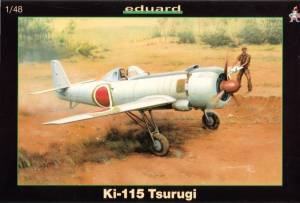 |
History
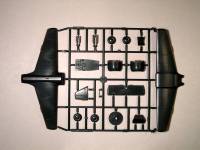 By
the fall of 1944 the Japanese empire was well aware that the tide of war
had changed to the allies' advantage. In response, a desperate scheme
was unveiled in which new pilots would be trained to conduct Taiatari,
special-attack or suicide missions. Initially the tactic achieved success,
which saw to an immediate expansion of the program. During the Battle
of Okinawa, hundreds of aircraft attacked the U.S. fleet resulting in
30 ships being sunk, and over 160 damaged. Over the next few months the
Japanese would sacrifice over 2,000 aircraft to such missions. Although
the results seemed promising, the scarcity of conventional aircraft caused
Japanese military leaders to consider building a new generation of simple,
low-cost, special-attack airplanes. These crude aircraft would be designed
with just enough performance to allow pilots with minimum training to
takeoff, cruise to the target, and make their final dive. By
the fall of 1944 the Japanese empire was well aware that the tide of war
had changed to the allies' advantage. In response, a desperate scheme
was unveiled in which new pilots would be trained to conduct Taiatari,
special-attack or suicide missions. Initially the tactic achieved success,
which saw to an immediate expansion of the program. During the Battle
of Okinawa, hundreds of aircraft attacked the U.S. fleet resulting in
30 ships being sunk, and over 160 damaged. Over the next few months the
Japanese would sacrifice over 2,000 aircraft to such missions. Although
the results seemed promising, the scarcity of conventional aircraft caused
Japanese military leaders to consider building a new generation of simple,
low-cost, special-attack airplanes. These crude aircraft would be designed
with just enough performance to allow pilots with minimum training to
takeoff, cruise to the target, and make their final dive.
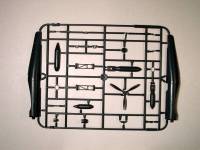 From
the outset the Nakajima Ki-115 'Tsurugi' (Sword) was designed as a "special-attack"
aircraft. While the initial batch was made from a variety of materials,
production aircraft were made of primarily wood and steel. The internal
frame and fuselage were steel; the engine cowling was made of rolled tin,
the wings of aluminum, while the tail consisted of a wooden framework
covered with fabric. The landing gear was nothing more than solid tubular
steel, designed to be jettisoned after take-off. The airframe was designed
to accommodate a number of different air-cooled radial engines, but all
production machines used the 14-cylinder radial Nakajima 23. The pilot
sat in an open cockpit above the trailing edge of the wing, and the only
armament consisted of a single 800 kg bomb semi-recessed under the forward
fuselage. From
the outset the Nakajima Ki-115 'Tsurugi' (Sword) was designed as a "special-attack"
aircraft. While the initial batch was made from a variety of materials,
production aircraft were made of primarily wood and steel. The internal
frame and fuselage were steel; the engine cowling was made of rolled tin,
the wings of aluminum, while the tail consisted of a wooden framework
covered with fabric. The landing gear was nothing more than solid tubular
steel, designed to be jettisoned after take-off. The airframe was designed
to accommodate a number of different air-cooled radial engines, but all
production machines used the 14-cylinder radial Nakajima 23. The pilot
sat in an open cockpit above the trailing edge of the wing, and the only
armament consisted of a single 800 kg bomb semi-recessed under the forward
fuselage.
In all, some 104 Ki-115's were produced, yet none of them entered operational
service. The only surviving copy of this unique aircraft is at the Garber
Facility of the National Air and Space Museum awaiting restoration.
 The
Kit The
Kit
With its recent series of releases, Eduard has clearly advanced into
the lead ranks of quality kit producers, and the Ki-115 Tsurugi is no
exception. The kit is the first in the Eduard line to demonstrate their
new 3D molding technology, as announced in their January 2004 newsletter.
If initial inspection of the kit is any indication, the future for model
enthusiasts is looking very bright!
The kit consists of three sprues molded in dark gray. The detail is
exquisite, and has to be seen first-hand to be appreciated. Rivets and
other surface details are delicately done, without a single trace of flash
or inappropriately placed mold sinks. The fit is flawless, and the smaller
parts are molded such that their connection to the gate is by a very slender
bit of sprue, thus making their removal a very easy and risk-free task.
Eduard has also included a fret of its Extraetch PE 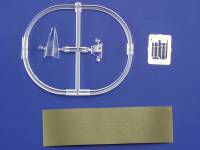 consisting
of pre-painted harnesses, along with a slice of Express Mask for the canopy
and other aircraft marking details. The decals come covered with a protective
sheet of tissue, and appear to be exceptionally well made, with accurate
color and registration. Insignia are provided for three different variations
of the aircraft. As with all Eduard products, the instructions are clearly
diagramed with excellent illustrations. consisting
of pre-painted harnesses, along with a slice of Express Mask for the canopy
and other aircraft marking details. The decals come covered with a protective
sheet of tissue, and appear to be exceptionally well made, with accurate
color and registration. Insignia are provided for three different variations
of the aircraft. As with all Eduard products, the instructions are clearly
diagramed with excellent illustrations.
Even if you're not a WWII fan, I strongly recommend that you go out
and purchase one of these kits, in order to see for yourself the level
of detail Eduard has achieved. As the original aircraft was of simple
construction, so too is the Eduard kit, and it promises to be an enjoyable
build without the distractions of filling, sanding, shaping, or fabricating
parts.
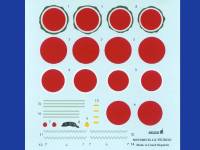 Conclusion Conclusion
Simply stated, this is a kit of unequaled quality, and Eduard should
be applauded for providing such high quality products to the hobby enthusiast.
Our thanks to Eduard for the review
sample.
|
|
